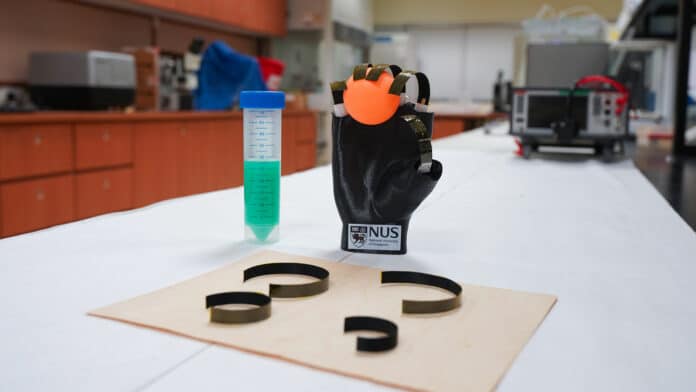Most robotic hand grippers are made from soft plastics, which can pick up objects without damaging them but melt at high temperatures, or metals, which are much more heat-tolerant but don’t have a particularly soft touch.
Now, researchers at the National University of Singapore (NUS) teamed up with colleagues from China’s Northeast Forest University to develop a wooden robotic gripper that could be used in extremely hot environments while maintaining a delicate touch. In addition, the gripper is driven by changes in moisture, temperature, and lighting in the environment, hence lowering energy consumption.
The wooden grippers are made from 0.5-millimeter-thick pieces of Canadian maple wood, which are first treated with sodium chloride to remove the lignin (a component found in the cell walls of plants). Researchers then filled the large pores in the wood with a polypyrrole polymer to allow the material to absorb heat and light more easily.
Next, the team coated one side of the modified wood pieces with a layer of nickel-based moisture-absorbing gel and attached a hydrophobic film to the other side. This wet-dry difference enables the wood to rapidly absorb water vapors on one side, facilitating faster changes in the shape of the wooden gripper when exposed to high humidity.
The wood pieces were then shaped into a gripper at 70 ºC using special molds. When the appendages were placed in an environment with a relative humidity of 95%, the hygroscopic gel took in moisture, and the wooden gripper stretched and gradually opened outwards.
Researchers also tested the wooden gripper under different light intensities, with the hydrophobic film layer facing the light source. When the light illumination increased the gripper’s surface temperature to about 42 ºC, the moisture-absorbing gel started to lose water, and the gripper began to bend inwards before achieving significant bending at about 57 ºC. The gripper showed durability and stability after undergoing 100 actuating cycles, demonstrating its suitability for long-term use.
During the experiments, the wooden gripper successfully lifted a weight of 200 grams (equivalent to a can of soda) at around 170 ºC without burning. Depending on the design, the wooden gripper could carry loads as high as 10,000 times the weight of the gripper, researchers say.
“Our wooden robotic gripper can spontaneously stretch and bend itself in response to moisture, thermal and light stimulation. It also has good mechanical properties, able to perform complex deformation, has a wide working temperature range, has low manufacturing cost, and is biocompatible. These unique features set it apart from conventional alternatives,” said Assistant Professor Tan Swee Ching, who leads a research team.
In the next step, the team plans to improve the wooden gripper’s performance, such as shortening the bending time from about 2 minutes currently, increasing the weight load it can carry, and gripping objects with different shapes and sizes. They are also finding ways to reduce costs and scale up the fabrication of the wooden gripper. They are also seeking to reduce costs and scale up the fabrication of the wooden gripper.
With further structural design and performance improvement, the team hopes to develop an improved version of the wooden gripper to help firefighters carry out rescue operations.
Journal reference:
- Lulu Bai, Yaoxin Zhang, Shuai Guo, Hao Qu, Zhen Yu, Haipeng Yu, Wenshuai Chen, Swee Ching Tan. Hygrothermic Wood Actuated Robotic Hand. Advanced Materials, 2023; DOI: 10.1002/adma.202211437
